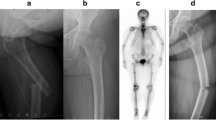Abstract
Stress fractures are common among female athletes, especially runners. Although both intrinsic and extrinsic factors can contribute to stress injury etiology, the female athlete triad—negative energy balance leading to menstrual irregularity, and reduced bone mineral mass—is a significant contributor to the incidence of stress fractures in the female athlete. When combined with impact weight-bearing activity, this triad puts these women at increased risk for stress fractures. Treatment must focus on reversing identified risk factors, in addition to relative rest, and maintenance of fitness. Most stress fractures heal without complication. High-risk stress fractures should be evaluated and treated by a practitioner with expertise in the care of these injuries.
Similar content being viewed by others
References and Recommended Reading
Wolff J: Das Gesetz der Transformation der Knochen. Berlin: A. Hirschwald; 1892. Published with support from the Royal Academy of Sciences in Berlin.
Knapp TE, Garrett WE: Stress fractures. Clin Sports Med 1997, 16:339–356.
Maitra RS, Johnson DL: Stress fractures. Clinical history and physical examination. Clin Sports Med 1997, 16:259–274. This article is a good review on the clinical evaluation of stress fracture.
Marcus R, Cann C, Madvig P, et al.: Menstrual function and bone mass in elite women distance runners. Endocrine and metabolic features. Ann Intern Med 1985, 102:158–163.
Callahan L: The athletic woman, stress fractures in women. Clin Sports Med 2000, 19:303–314.
Matheson GO, Clement DB, McKenzie DC, et al.: Stress fracture in athletes. Am J Sports Med 1987, 15:46–58. This article looked at the relationship between stess fractures in athletes and a wide variety of risk factors.
Rumball JS, Lebrun CM, Di Ciacca SR, Orlando K: Rowing injuries. Sports Med 2005, 35:537–555.
Coris EE, Higgins HW: First rib stress fractures in throwing athletes. Am J Sports Med 2005, 33:1400–1404.
Jones DC, Bovee MW, Harris JM: Intrinsic risk factors for exercise-related injuries among male and female army trainees. Am J Sports Med 1993, 21:705–710.
Shaffer RA, Brodine SK, Almeida SA, et al.: Use of simple measures of physical activity to predict stress fractures in young men undergoing a rigorous physical training program. Am J Epidemiol 1999, 149:236–242.
Jones DC, James SL: Overuse injuries of the lower extremity: shin splints, iliotibial band friction syndrome, and exertional compartment syndromes. Clin Sports Med 1987, 6:273–290.
Barrow GW, Saha S: Menstrual irregularity and stress fractures in collegiate female distance runners. Am J Sports Med 1988, 16:209–216.
Beck TJ, Ruff CB, Shaffer RA, et al.: Stress fracture in military recruits: gender differences in muscle and bone susceptibility factors. Bone 2000, 27:437–444.
Cooper L, Joy EA: Osteoporosis in a female cross-county runner with femoral neck stress fracture. Curr Sports Med Rep 2005, 4:321–322.
Taunton JE, Ryan MB, Mackenzie DC, et al.: A retrospective case-control analysis of 2002 running injuries. Br J Sports Med 2002, 36:95–101.
Bennell KL, Malcolm SA, Thomas SA, et al.: Risk factors for stress fractures in track and field athletes. A twelve-month prospective study. Am J Sports Med 1996, 24:810–818. This prospective study links various risk factors with the development of stress fractures in track and field athletes.
Torstveit MK, Sundgot-Borgen J: The female athlete triad: are elite athletes at increased risk? Med Sci Sports Exer 2005, 37:184–193.
Korpelainen R, Sakari O, Karpakka J, et al.: Risk factors for recurrent stress fractures in athletes. Am J Sports Med 2001, 29:304–310. This article looked at the relationship between stress fractures in athletes and a wide variety of risk factors.
De Souza MJ, Williams NI: Physiological aspects and clinical sequelae of energy deficiency and hypoestrogenism in exercising women. Hum Reprod Update 2004, 10:433–448.
Armstrong DW, Rue JPH, Wilckens JH, Frassica FJ: Stress fracture injury in young military men and women. Bone 2004, 35:806–816.
Gaeta M, Minutoli F, Scribano E, et al.: CT and MR imaging findings in athletes with early tibial stress injuries: comparison with bone scintigraphy findings and emphasis on cortical abnormalities. Radiology 2005, 235:553–561.
Bergman AG, Fredericson M, Ho C, Matheson GO: Aymptomatic tibial stress reactions: MRI detection and clinical followup in distance runners. AJR 2004, 183:635–638.
Joy EA, Wilson C, Varechok S: The multidisciplinary team approach to the outpatient treatment of disordered eating. Curr Sports Med Rep 2003, 2:331–336. This article highlights multidisciplinary treatment of patients with disordered eating in the outpatient setting.
Khan AA, Bachrach L, Brown JP, et al.: Canadian Panel of the International Society of Clinical Densitometry. Standards and guidelines for performing central dual-energy x-ray absorptiometry in premenopausal women, men, and children. J Clin Densitom 2004, 7:51–64.
Keen AD, Drinkwater BL: Irreversible bone loss in former amenorrheic athletes. Osteoporos Int 1997, 7:311–315.
Stewart GW, Brunet ME, Manning MR, Davis FA: Treatment of stress fractures in athletes with intravenous pamidronate. Clin J Sport Med 2005, 15:92–94.
Allen CS, Flynn TW, Kardouni JR, et al.: The use of pneumatic leg brace in soldiers with tibial stress fractures: a randomized clinical trial. Mil Med 2004, 169:880–884.
Tanner SM: Preparticipation examination targeted for the female athlete. Clin Sports Med 1994, 13:337–353.
Author information
Authors and Affiliations
Rights and permissions
About this article
Cite this article
Joy, E.A., Campbell, D. Stress fractures in the female athlete. Curr Sports Med Rep 4, 323–328 (2005). https://doi.org/10.1007/s11932-005-0017-5
Published:
Issue Date:
DOI: https://doi.org/10.1007/s11932-005-0017-5




